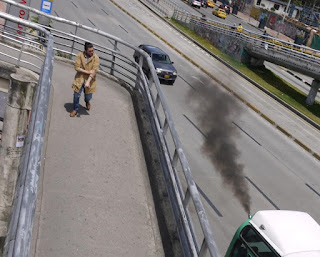 |
| 'Not One More Death!' Cyclists protest the recent death of a Bogotá bicyclist. |
I'm writing this from northern California, where I'm visiting my
 |
| A video by the El Espectador newspaper chronicles the number of Bogot'a cyclists killed annualy, generally more than 50. |
| The 'Cicloruta' on Calle 13, in Bogotá. Can you see it amidst all those pedestrians? |
In contrast, in northern California, most bike lanes are wide, well-maintained and on streets, where
| A California bike lane. Nice - but where are the cyclists? |
| A bicyclist (behind taxi/red arrow) tries to cross a Bogotá intersection blocked by cars which ran the red light. |
(When I block the cars to give an old lady a chance to cross, motorists insult me for it.)
Cycling across an intersection often becomes a game of chicken with drivers who run red lights or
| Seldom seen in Bogotá: California cars stop and wait to let a pedestrian cross a street. |
In contrast, here in the Bay Area when I even APPROACH an intersection drivers stop. Is something wrong? I wonder. No, they're waiting for me to cross. Is this out of courtesy, or because they're terrified of getting sued? Does it matter?
Of course, cyclists violate lots of traffic rules. But the general atmosphere of chaos and lack of civility on Bogotá streets makes a cyclist shake his shoulders and ask 'Why obey rules, if nobody else does?'
 |
| A Bogotá bus appears to aim its smokey exhaust at a pedestrian. |
Besides the obvious health impacts, this just makes bicycling unpleasant. In California, which has some of the world's strictest emissions laws, even in congested areas I barely sense fumes at all.
The first of these problems requires an engineering fix, and city planners appear to be improving: All the new bike lanes I've seen are on streets.
But the other two issues involve culture, which is tougher to change. Perhaps less apathetic (and less
 |
| New York City bicycling accident rates have fallen steeply. (Graph: N.Y. D.O.T.) |
Yet, for all that, Bogotá has many more cycle commuters than do northern California's suburbs - and perhaps even more than does bike-friendly San Francisco.
That's why I'm becoming convinced that making cycling pleasant and making it popular are two very different - but related - issues. Fixing these troubles will lure onto two wheels only those people who already would like to bicycle, but are afraid to. To get more people to WANT to cycle will require more fundamental social changes.
By Mike Ceaser, of Bogotá Bike Tours
No hay comentarios:
Publicar un comentario